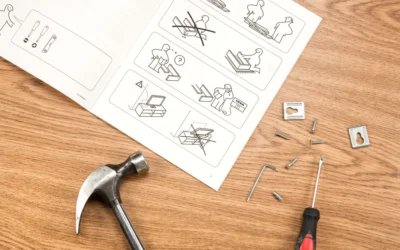Ever felt like moving is a mix of hopscotch and tug-of-war? As you sort through your stuff you’ll probably face countless mini dilemmas such as whether you have really outgrown the neon flamingo lamp you’ve had since college or if donating your inherited collection of Hummel figurines. makes you a bad person. Well, we’re here to tell you: do what you have to do to stay sane.
Decluttering before moving is crucial. It helps you lighten the load and also give you a chance to start fresh in your new space. The best moving experiences often have a strategic declutter-to-move approach. Let’s dive in!
Start Early and Set Deadlines
Ever felt that time sneaks away, especially when there is a heap of tasks on your plate? When it comes to moving, that sentiment couldn’t be truer. Sifting through boxes, remembering forgotten treasures and deciding what makes the cut — it can be quite the endeavor. And here’s a pro tip: The sooner you dive in, the less chaotic it will be later on.
Professional organizer Seana Turner advocates for an early start. “Decluttering takes time,” she said, “especially if you don’t want to feel pressured.”
Think about it: Would you rather be in a mad dash or confidently stride through the process? Yup, thought so.
Start by marking those decluttering sessions on your calendar, like important appointments you can’t miss. Circle them, highlight them, make them stand out. And while you’re at it, block off a chunk of time specifically for hauling away the bigger items you are parting with.
Handle One Room at a Time
We humans can be quite ambitious, can’t we? But if you’re wondering how to declutter when moving, trying to tackle the entire house in one go might not be the answer. In fact, it can leave us sprawled on the living room floor, surrounded by years of ‘essential’ knick-knacks.
“Focus on one room at a time,” said Robyn Reynolds, a professional organizer and owner of Organize 2 Harmonize, “and start in areas of your home that you use the least.”
This way you have full access to the areas that get used all the time for as long as possible.
Note that each room has its quirks. For instance, the garage might be home to old sports gear or forgotten DIY projects. The attic? Probably a haven for sentimental items and Halloween decorations from 10 years ago. Your bedroom closets might be holding onto fashion trends that… well, let’s just say they’ve seen better days. And let’s not even start on the kitchen with its mysterious gadgetry.
The secret? Patience, strategy and a good playlist to groove to as you declutter.
Sort Your Items
Decluttering involves making decisions, and to make the right ones, you need smart categorization. For those pondering how to declutter when moving, use the move as a catalyst for a fresh start at being organized in your new home.
Having a mountain of belongings to sift through might seem overwhelming, but breaking things down step-by-step makes it all manageable. So, here we go, one category at a time.
- Keep and move into new home: Generally speaking, if you are moving to a short-term, furnished apartment, you will need only what’s missing: clothes, your laptop or a favorite blanket or coffee mug for example. A long-term relocation to an unfurnished home would require you to take as much furniture as you can with you.
- Keep but move into storage: For those who are downsizing especially, storage is a blessing. At SpareFoot, over half of our customers are looking for storage around a move. That nostalgic typewriter or the baby crib from a decade ago might not fit today’s scene but are too dear to part with. Other storage favorites include holiday decorations, books, toys, seasonal clothing and old furniture.
- Sell: Before you box up and head out, consider hosting a garage sale. It will pad your moving budget, and hey, neighbors might just score some finds from your stash. Your garden gnome or that quirky vase might just find a new home next door. Besides the traditional garage sale, online marketplaces like Facebook Marketplace, Craigslist or OfferUp can be great platforms to find buyers.
- Donate or give away: Your surplus might be someone else’s essential. Elizabeth Peace in Fort Meade, MD, who regularly relocated with her military family, shared her go-to strategy when it comes to furniture. “If it’s cheap furniture and I think it will fall apart with a cross-country move, or it’s a piece I haven’t used in two years, I will donate it,” she said. “If it’s a nice piece and I’m worried about taking it overseas, I store it.”
- Trash: In the whirlwind of moving, you will come across items that neither spark joy nor serve a functional purpose anymore. Figuring out how to declutter when moving means identifying these items, from expired food to worn-out items and those random knick-knacks that won’t be of value to donate.
Letting go of things can be tough, we know. If decluttering isn’t your forte, here is a simple trick from Jenny Butler, who relocated from Los Angeles to St. Louis with her family: get a second opinion.
“Bring in a ruthless friend to help you,” Butler suggested. “Not every item you own is special. Be willing to part with stuff.”
Ask Yourself Tough Questions
Peace turns to her tried-and-true list of questions every time she’s preparing to move and needs to decide what’s coming with her and what’s staying behind. Here are a few that you can also include on your pre-move checklist:
- Do I want to have to repurchase this item?
- Have I used this item in the last two years?
- Do I need to downsize for a smaller space?
- Do I have multiples of this item and do I need more than one?
- Do I love this item? If not, why put the effort into moving it across the country?
For instance, when she and her husband were moving from Des Moines to Los Angeles, Agnes Choi made the decision to sell a lot of their big furniture.
“For one, it’s a lot of effort to move bigger furniture items,” she said. “But with professional movers, the price significantly increased to go across the country and include our big, heavy furniture items. We decided we might as well sell the items and spend that money on buying new furniture once we got settled into our home.”
Bottom line: Some things, especially bulky furniture, are just not worth taking unless they are investment items. Plus, they could get damaged in the move. This can be more hassle than what the items are worth.
Ready, Set, Declutter!
Moving? Time to declutter. By kicking off early, tackling one room at a time and being real with what to keep, sell, donate or toss, you are on track for a fuss-free move.
Remember to ask yourself the hard questions and lean into the fresh start ahead. When you declutter before moving, you are lightening the load and setting the scene for new memories in a clutter-free space. That’s a pretty big thing.



